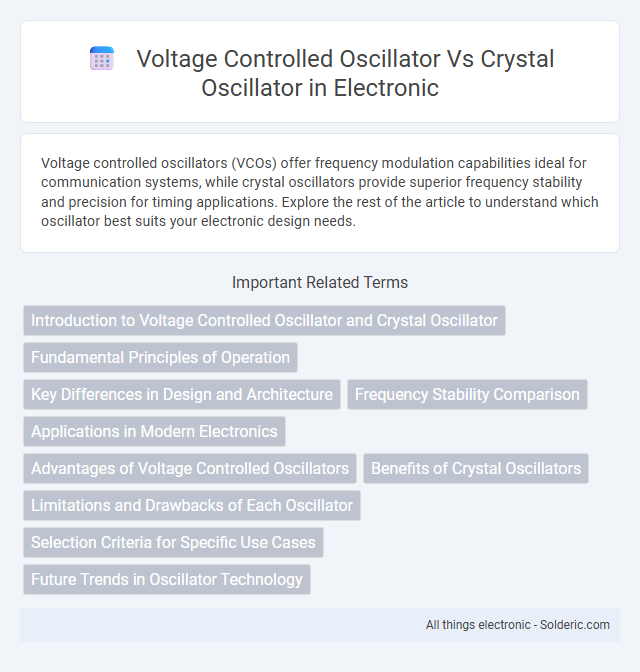Voltage controlled oscillators (VCOs) offer frequency modulation capabilities ideal for communication systems, while crystal oscillators provide superior frequency stability and precision for timing applications. Explore the rest of the article to understand which oscillator best suits your electronic design needs.
Comparison Table
| Feature | Voltage Controlled Oscillator (VCO) | Crystal Oscillator |
|---|---|---|
| Frequency Control | Controlled by voltage input, enables frequency tuning | Fixed frequency determined by crystal's physical properties |
| Frequency Stability | Moderate stability, varies with temperature and voltage | High stability, minimal drift over time and temperature |
| Frequency Range | Wide frequency range, typically MHz to GHz | Narrow frequency range, typically limited to specific crystal frequencies |
| Phase Noise | Higher phase noise compared to crystal oscillators | Low phase noise, ideal for precision applications |
| Applications | Frequency modulation, phase-locked loops (PLLs), communication systems | Clocks, microcontrollers, precision timing, communication reference signals |
| Cost | Generally lower cost and simpler design | Higher cost due to precision crystal manufacturing |
| Size | Smaller and more compact | Larger due to the crystal component |
Introduction to Voltage Controlled Oscillator and Crystal Oscillator
Voltage Controlled Oscillators (VCOs) generate a frequency output that varies based on an input control voltage, making them essential in phase-locked loops and frequency modulation applications. Crystal Oscillators provide highly stable and precise frequency signals through the mechanical resonance of a quartz crystal, commonly used in clocks and communication systems. Your choice depends on whether frequency tunability (VCO) or frequency stability (Crystal Oscillator) is more critical for the application.
Fundamental Principles of Operation
Voltage controlled oscillators (VCOs) generate variable frequency signals based on the input control voltage that changes the capacitance or inductance in an LC circuit, allowing continuous frequency tuning. Crystal oscillators rely on the piezoelectric effect in quartz crystals, where the crystal's mechanical resonance produces a highly stable and precise oscillation frequency. The fundamental difference lies in VCOs offering frequency agility through voltage variation, while crystal oscillators provide superior frequency stability via fixed crystal resonance.
Key Differences in Design and Architecture
Voltage controlled oscillators (VCOs) utilize varactor diodes to adjust frequency through voltage input, offering wide tunability and rapid frequency modulation suited for phase-locked loops and frequency synthesis. Crystal oscillators rely on quartz crystals exhibiting piezoelectric properties, providing highly stable and precise frequency references due to their mechanical resonance, but with limited frequency adjustment capabilities. Your choice depends on whether frequency agility (VCO) or frequency stability and low phase noise (crystal oscillator) are paramount in the application.
Frequency Stability Comparison
Voltage controlled oscillators (VCOs) offer frequency tunability but exhibit lower frequency stability compared to crystal oscillators. Crystal oscillators maintain superior frequency stability due to their quartz crystal resonators, which provide precise and consistent oscillation frequencies with minimal drift over temperature and time. When your application demands high precision and stable frequencies, crystal oscillators are the preferred choice over VCOs.
Applications in Modern Electronics
Voltage controlled oscillators (VCOs) are widely used in phase-locked loops (PLLs) for frequency synthesis, modulation in communication systems, and signal generation in synthesizers. Crystal oscillators provide high-frequency stability and precision, making them essential for clock generation in microprocessors, GPS devices, and timing applications in telecommunications. Modern electronics leverage VCOs for tunable frequencies and rapid frequency hopping, while crystal oscillators ensure long-term frequency accuracy and low phase noise.
Advantages of Voltage Controlled Oscillators
Voltage controlled oscillators (VCOs) offer significant advantages with their frequency tunability, allowing precise control over oscillation frequency in response to voltage variations. VCOs are essential in phase-locked loops and frequency synthesis, providing rapid frequency modulation for communication systems and signal processing. Your design benefits from VCOs' ability to generate a wide range of frequencies, enabling versatile and adaptive electronic applications.
Benefits of Crystal Oscillators
Crystal oscillators offer superior frequency stability and precision compared to voltage controlled oscillators, making them ideal for applications requiring accurate timing and low phase noise. Their inherent property of using quartz crystals ensures minimal frequency drift over temperature and time variations. This reliability in maintaining a fixed frequency supports critical functions in communication systems, clocks, and microprocessors.
Limitations and Drawbacks of Each Oscillator
Voltage controlled oscillators (VCOs) suffer from frequency instability due to temperature variations and noise, leading to phase noise and jitter issues that affect precision timing applications. Crystal oscillators offer superior frequency stability and low phase noise but are limited by their fixed frequency output and sensitivity to mechanical shocks, which can cause frequency drift or damage. Your choice depends on whether you prioritize tunability and agility in frequency control (VCO) or the long-term frequency accuracy and low noise performance of crystal oscillators.
Selection Criteria for Specific Use Cases
Voltage controlled oscillators (VCOs) are preferred in applications requiring frequency modulation, tunability, and phase-locked loops, such as communication systems and synthesizers, due to their adjustable frequency output. Crystal oscillators offer superior frequency stability, low phase noise, and precision timing, making them ideal for clocks, microcontrollers, and high-accuracy instruments. Selection depends primarily on the need for frequency agility versus stability, with VCOs suited for dynamic frequency control and crystal oscillators favored for fixed-frequency precision tasks.
Future Trends in Oscillator Technology
Voltage controlled oscillators (VCOs) and crystal oscillators are evolving with advancements in semiconductor materials and integrated circuit design, enabling higher frequency stability and tunability for 5G and IoT applications. Emerging trends include the integration of MEMS-based resonators with VCOs to enhance phase noise performance while maintaining compact form factors in wireless communication devices. Research into novel piezoelectric materials and digital calibration techniques is also driving improvements in the energy efficiency and frequency accuracy of both oscillator types.
Voltage controlled oscillator vs Crystal oscillator Infographic

 solderic.com
solderic.com